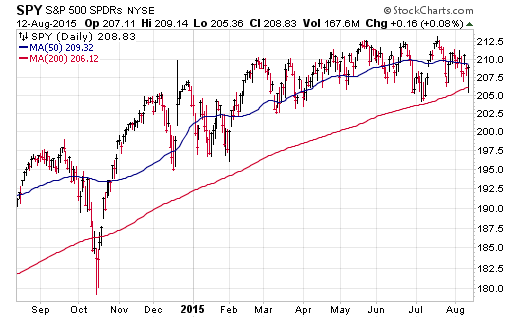 Today marked the first time the SPDR S&P 500 ETF (SPY) broke below its 200-day moving average in 2015. We came close in early July, but managed to escape a full-fledged dip below the long-term trend line. Nevertheless, it is decision time for trend followers that use this metric as a guidepost for buy and sell triggers.
Today marked the first time the SPDR S&P 500 ETF (SPY) broke below its 200-day moving average in 2015. We came close in early July, but managed to escape a full-fledged dip below the long-term trend line. Nevertheless, it is decision time for trend followers that use this metric as a guidepost for buy and sell triggers.
As I wrote back in June, and what is clear on the chart below, is that this occurrence was more the result of the 200 day moving average running into the price of the S&P 500 ETF (SPY) rather than the other way around. SPY has essentially been moving sideways in a tight coiled range since early February. Despite multiple attempts at a breakout, this index has been unable to build enough momentum to reach escape velocity and this has hindered the broader stock market.
The upward sloping 200 day moving average essentially caught up with the sideways price action in stocks and created an event that is likely to carry less weight than other technical breakdowns of this nature that have come before. In addition, it’s worth noting that the October 2014 break below the 200-day moving average lasted for a very short period of time before stocks rocketed to new highs.
Will this time be different and spark a more pronounced round of selling?
So far, the early indications are that the test below the 200-day average may have been a false breakdown that initiated an intra-day reversal to the upside. This isn’t astonishing considering the support that was established near $205 on SPY and 2040-2050 on the S&P 500 Index.
If the market continues higher from here as investors pile back in to catch the next move higher, we could see a measured move back to the $214 high of the year. Nevertheless, I would not be surprised to see this recent low tested at least once more in the coming weeks in order to shake out weak hands and potentially run new stop losses.
Rather than using the 200 day moving average as a traditional sell point, I would be looking to place any meaningful risk management measures in place at defined areas of support. The $205 level is certainly noteworthy. In addition, those that want to give their positions more breathing room may ultimately look to the $197.50 support level that was established back in January.
Remember that when implementing a risk management plan, you want to weigh the benefits of reducing equity exposure against the risks of missing the next rally. In 2015, the play book has been definable areas of support and resistance that coincide with inflection points of volatility. Until a breakdown in that pattern occurs, we can use those opportunities to increase and decrease exposure to stocks.
Twitter: @fabiancapital
No position in any of the securities mentioned at the time of publication. Any opinions expressed herein are solely those of the author, and do not in any way represent the views or opinions of any other person or entity.








